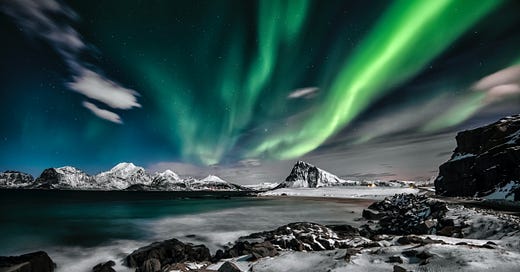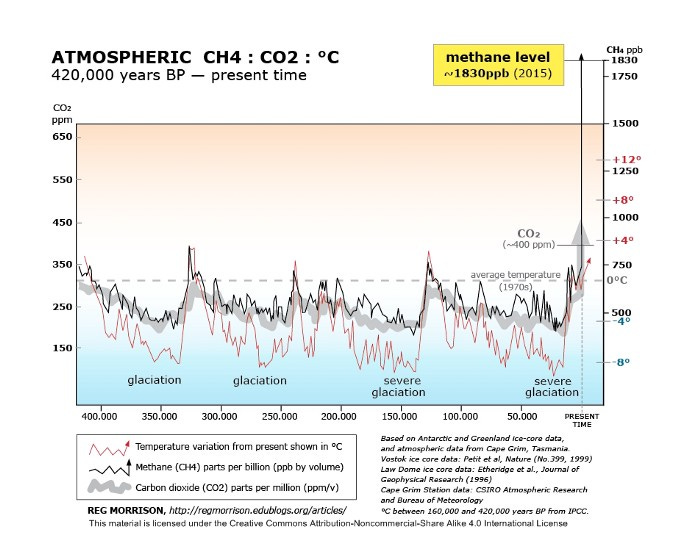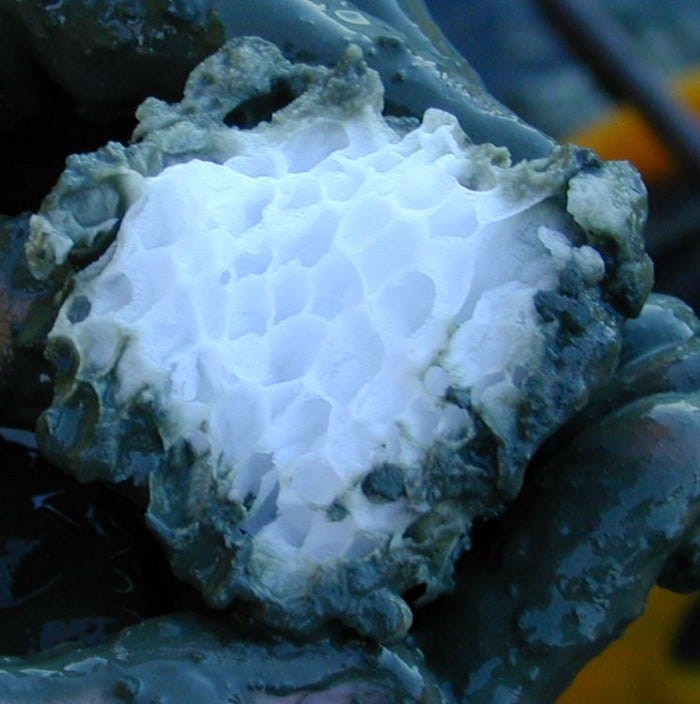Photo by Stein Egil Liland
Let me be honest with you: I’m a natural pessimist. When people question having children because of the coming ecological apocalypse, I’m with them all the way. The apparently unstoppable nature of climate change is the most urgent concern we’re facing as humanity. Quoting James Lovelock:
We are on the edge of the greatest die-off humanity has ever seen. We will be lucky if 20% of us survive what is coming. We should be scared stiff.
The warming trend is already very worrying. Even more scary is the possibility of runaway climate change. As humans, we naturally think in terms of linear cause-effect relationships. If we put twice as much CO2 into the atmosphere, the warming effect will be twice as strong. Right? Wrong. The Earth is a living system, full of nonlinear, self-reinforcing mechanisms. The more global warming, the more ice melts in the Arctic. The more white ice melts into dark water, the more warmth is absorbed instead of reflected, reinforcing global warming.
In the Permian-Triassic extinction event, the most significant die-off in the history of life, 96% of marine species, and the majority of all life forms became extinct. Did runaway climate change cause this? Can it happen again?
The Methane Bomb
One of the scariest potential tipping points is an accelerated release of methane. You can find sensational articles on conspiracy websites with vivid headlines like:
However, let's switch off the paranoia mode and look at what is really going on here.
Methane is a carbohydrate, like oil. Its chemical formula is CH4: one carbon atom is bound to four hydrogen atoms. Unlike oil, which is liquid, methane is gaseous. Methane is pretty abundant, and the main constituent of natural gas. In addition to geological methane reserves, it's also produced biologically, by microorganisms living in sediments, peat bogs, and cow intestines.
source: Reg Morrison
Methane concentrations in the atmosphere have been rising steeply. Human-caused emissions are the main reason. Atmospheric methane, i.e., methane in the air, is a potent greenhouse gas. Each molecule of methane traps up to 100 times as much heat as a molecule of CO2. Atmospheric methane is now responsible for about 20% of global warming. A significant fraction of that comes from livestock — a compelling argument for veganism. But I'm digressing.
What are Clathrates?
source: Wikimedia
The largest reservoir of methane is under the seafloor in the form of methane clathrates. These are methane molecules, trapped in a lattice of ice, frozen water. The result is "burning ice". Put a lighter to a block of such ice, and it will burn. That's quite funny. What follows is not.
One cubic meter of clathrate ice holds as much as 180 cubic meters of compressed methane gas inside of it. Melting clathrates release a large amount of methane. And there's a lot of it. Nobody knows precisely how much, but a decent estimate is 5000 GtC (gigatons of carbon). To put that into context: that's about seven times the size of the world's total oil reserves. Reserves which themselves far exceed our carbon budget, if we want to keep the earth habitable.
Clathrates are stable under pressure, and when cold enough. Most clathrate reserves are deep in the ocean, underneath a water column that is high enough, and heavy enough, and cold enough to keep a lid on the stuff. But near Siberia, in the East Antarctic Siberian shelf, clathrates are stored at shallow depths, held not by depth pressures but by the cold and a lid of permafrost.
The Melting Arctic
source: Wikipedia
In the early 2000s, it became increasingly evident that the Arctic is heating up much faster than the world as a whole. Scientists and journalists report apocalyptic scenes. "Western scientists cannot imagine the scale of the melting," a Russian researcher says.
More worryingly, the melting causes releases of methane gas trapped in clathrate methane ice below the melting permafrost. Is the clathrate release triggering a self-reinforcing doom loop, where more methane increases the melt, causing the release of even more methane?
This doom loop is called the Clathrate Gun Hypothesis: once fired, the effect cannot be undone.
An Abrupt Doubling Of Global Warming
Research in Siberia by Natalia Shakhova and Igor Semiletov showed that millions of tons of methane are leaking into the atmosphere. Perforations in the seabed permafrost allow the gas to escape. Concentrations in some regions reach up to 100 times normal levels.
The research results, published in the March 5, 2010, edition of the journal Science, show that the permafrost under the East Siberian Arctic Shelf, long thought to be an impermeable barrier sealing in methane, is perforated and is leaking large amounts of methane into the atmosphere. Release of even a fraction of the methane stored in the shelf could trigger abrupt climate warming.
Natalia Shakhova, Igor Semiletov: Arctic seabed methane stores destabilizing, venting
The amounts of methane stored are massive. Even if only a few percent escape into the atmosphere, that's still 50 Gigatons of methane. Such an event would multiply the methane content of the planet's atmosphere twelvefold, equivalent in the greenhouse effect of a doubling in the current level of CO2. Suddenly.
In this 2012 video, Shakhova explains what is going on. "We do not like what we see there" is science speak for: "I'm scared shitless, and you should be too".
Research in the Americas painted a similarly worrying picture of clathrates being disturbed by landslides caused by the intrusion of warming ocean currents. Climate models incorporating a sudden methane pulse showed increases in atmospheric temperatures by more than 6°C within 80 years.
Not So Fast
That woke people up alright and triggered several follow-up studies to gain a deeper understanding of what was going on.
Recent research shows, that methane plumes in the ocean near the Svalbard islands, which initially were suspected to be caused by current global warming, have been ongoing at the same rate for millions of years. Heat from the surface only reaches the top 1.6 meters of clathrate, which then destabilizes only very slowly (over centuries). Crucially, the break-up of the topmost level of clathrates absorbs energy, protecting lower layers against heating up.
A 2016 USGS review co-authored by John Kessler, who originally coined the term "Clathrate gun," concluded that the whole scare was a false alert.
After so many years spent determining where gas hydrates are breaking down and measuring methane flux at the sea-air interface, we suggest that conclusive evidence for release of hydrate-related methane to the atmosphere is lacking.
Gas Hydrate Breakdown Unlikely to Cause Massive Greenhouse Gas Release
Once again, one has to translate science speak of "evidence is lacking" into plain English: "Thank God it's all bullshit." Read the full article to get all the nitty-gritty details.
Follow-up reviews lead to similar conclusions: human-induced methane emissions outweigh natural sources — meaning we can change the trajectory by changing policies.
Deep Adaptation
The Paper ‘So Depressing It Sends People To Therapy’
I started looking into the Clathrate Gun story because of the 2018 Deep Adaptation paper by Jem Bendell. This paper highly influences the Extinction Rebellion movement. It foregrounds runaway clathrate release as already ongoing, and one of the reasons we should accept by now that climate change is irreversible. The paper argues that we should accept we're all fucked.
But hang on, wasn’t the Clathrate Gun hypothesis just debunked? Yes, it was. So how come this is still brought up?
Michael Mann, a prominent climate scientist, dismissed the Deep Adaptation paper as "crap" — he argues it is detrimental to effective climate policy by promoting an attitude of despair. Without mentioning Bendell or the paper by name, he's infuriated by the pseudo-science involved and doesn't mince words in this video:
So, We’re Good?
Well, no, not really. In terms of clathrates (methane ice hydrates), sure, that's now shown to be far less scary than people thought a few years ago. But that doesn't get us off the hook for other sources of methane, currently destabilizing in the ESAS (East Siberian Arctic Shelf). Dr. Shakhova (2017):
The importance of hydrates involvement in methane emissions is overestimated. The hydrate is just one form of possible reservoirs, in which pre-formed methane could be preserved in the seabed if there are proper pressure/temperature conditions; it is just the layer of hydrates composes just few hundred of meters — this is a very small fraction compared to thousands of meters of underlying gas-charged sediments in the ESAS (East Siberian Arctic Shelf).
The increasing melt of the Arctic thaws a layer of undersea permafrost that acts as a cork holding back reservoirs of stored methane. With the cork disappearing, we risk an exponential release of methane. In other words: the clathrate gun is a dud, but the methane bomb may still be live and ticking.
The scientific consensus is currently that human actions predominantly cause atmospheric methane. The concentrations are too high, and we urgently need to take actions that reduce methane emissions from livestock and fossil fuel mining leaks.
Dr. Shakova and her collaborators insist that we face a significant methane risk in the Arctic. They see and measure anomalous methane releases as bubble columns in the water, and blowout escapes on the land. Only time will tell whether these concerns remain maverick outliers, or gain more evidence and acceptance into mainstream thinking.
The following two articles nicely summarize the current (2020) state of play: Methane Emergency and Debunked: The Methane Monster. You’ll find plenty of details there. Moreover, the articles contain videos of leading climate experts speaking out on the topic. Check it out.
Now I’m Confused
Uh, why are you confused? Because scientific opinion changes, as more evidence is uncovered and insight deepens? Because it's all very technical and detailed and requires a hell of a lot of expertise to understand the nuances and mechanisms? Because debate remains ongoing and there's never a final, definitive truth? Because it feels like we’re doomed, hence it must be true that we are?
I’m not saying we’re not doomed — we may well be. To be clear: I fully support Extinction Rebellion in their demands for a fast and fundamental change in our society. But I also hold, that reasoning backward from conclusions (”we must change course”) to facts on the ground (”runaway climate change is ongoing, and clathrate release plays a significant role”) is — well, backward.
Disrespect for science, obfuscation, misrepresentation, and cynical propaganda are features of the current media landscape that arguably play a big part in our inability to, as humanity, find common ground and undertake effective action in the face of an existential threat.
Emotions of fear and despair are real and valid. Acting on those emotions is crucial. But letting our desire for a narrative that resonates, prevail over critical thinking and truth-finding is a trap that degrades our ability to design and implement effective climate actions.
What do you think and feel after reading this? I would love to hear your response.








Well documented! Our little answer — regardless of what may cause human catastrophe on planet earth eg: Nuclear War, Climate Change, Covid or similar, etc — is to support a Partnership oriented Culture, re-learning ways to deeply Connect with each other, enhancing our Collaboration & our human Creativity. We call this Culture Gardening, and it’s a 200 year plan. We may not have that much time, but no time like the present moment:
www.CultureGarden.org